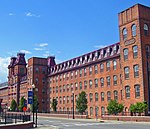Enlarged Erie Canal Historic District (Discontiguous)

Enlarged Erie Canal Historic District (Discontiguous) is a national historic district located at Cohoes in Albany County, New York. It includes two contributing buildings and 10 contributing structures. It encompasses resources associated with the Enlarged Erie Canal, 1835–1862, Locks 9 through 18, and located within the City of Cohoes. The district includes five numbered units with each unit representing a cohesive grouping of resources highlighted by one or more extant canal locks. Each unit consists of at least one remaining lock and the associated elements including sections of towpath, berm walls, engineering features, and canal prism. Unit 1: Lock 9 Unit 2: Lock 10 Unit 3: Locks 14 and 15 Unit 4: Lock 17 Unit 5: Lock 18It was listed on the National Register of Historic Places in 2004.
Excerpt from the Wikipedia article Enlarged Erie Canal Historic District (Discontiguous) (License: CC BY-SA 3.0, Authors, Images).Enlarged Erie Canal Historic District (Discontiguous)
Cohoes National Heritage Trail,
Geographical coordinates (GPS) Address Nearby Places Show on map
Geographical coordinates (GPS)
| Latitude | Longitude |
|---|---|
| N 42.7775 ° | E -73.703055555556 ° |
Address
Enlarged Erie Canal Lock 15
Cohoes National Heritage Trail
12047
New York, United States
Open on Google Maps







